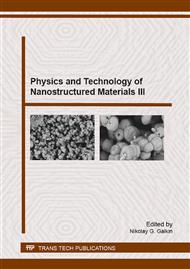[1]
S.A. Novikova, S.A. Yaroslavtsev, V.S. Rusakov, T.L. Kulova, A.M. Skundin, A.B. Yaroslavtsev, Lithium intercalation and deintercalation into lithium–iron phosphates doped with cobalt, Mendeleev Commun. 23 (2013) 251–252.
DOI: 10.1016/j.mencom.2013.09.003
Google Scholar
[2]
S.V. Makaev, V.K. Ivanov, O.S. Polezhaeva, Yu.D. Tret'yakov, T.L. Kulova, A.M. Skundin, O.A. Brylev, Electrochemical intercalation of lithium into nanocrystalline ceria, Russ. J. Inorg. Chem. 55 (2010) 991–994.
DOI: 10.1134/s0036023610070016
Google Scholar
[3]
S.V. Gnedenkov, D.P. Opra, V.V. Zheleznov, S.L. Sinebryukhov, E.I. Voit, A.A. Sokolov, Yu.V. Sushkov, A.B. Podgorbunsky, V.I. Sergienko, Nanostructured zirconia-doped titania as the anode material for Li-ion battery, Russ. J. Inorg. Chem. 60 (2015).
DOI: 10.1134/s0036023615060054
Google Scholar
[4]
X. Wang, J. Shang, Z. Luo, L. Tang, X. Zhang, J. Li, Reviews of power systems and environmental energy conversion for unmanned underwater vehicles, Renew. Sust. Energ. Rev. 16 (2012) 1958–(1970).
DOI: 10.1016/j.rser.2011.12.016
Google Scholar
[5]
A. Yu. Tsivadze, T.L. Kulova, A.M. Skundin Fundamental problems of lithium-ion rechargeable batteries, Prot. Met. Phys. Chem. 49 (2013) 145–150.
DOI: 10.1134/s2070205113020081
Google Scholar
[6]
T.L. Kulova, A.M. Skundin, Yu.E. Rogynskaya, F.K.H. Chibirova, Degradation mechanism of mixed nanostructured tin and titanium oxides when cycled, Russ. J. Electrochem. 42 (2006) 1019–1030.
DOI: 10.1134/s1023193506090011
Google Scholar
[7]
A.M. Skundin, O.N. Efimov, O.V. Yarmolenko, The state-of-the-art and prospects for the development of rechargeable lithium batteries, Russ. Chem. Rev. 71 (2002) 329–346.
DOI: 10.1070/rc2002v071n04abeh000706
Google Scholar
[8]
T.L. Kulova, New electrode materials for lithium-ion batteries (Review), Russ. J. Electrochem. 49 (2013) 1–25.
DOI: 10.1134/s1023193513010102
Google Scholar
[9]
M.F. Hassan, Z.P. Guo, Z. Chen, H.K. Liu, Carbon-coated MoO3 nanobelts as anode materials for lithium-ion batteries, J. Power Sources 195 (2010) 2372–2376.
DOI: 10.1016/j.jpowsour.2009.10.065
Google Scholar
[10]
A. Ponrouch, P. -L. Taberna, P. Simon, M.R. Palacín, On the origin of the extra capacity at low potential in materials for Li batteries reacting through conversion reaction, Electrochim. Acta 61 (2012) 13–18.
DOI: 10.1016/j.electacta.2011.11.029
Google Scholar
[11]
R. Nadimicherla, Y. Liu, K. Chen, W. Chen, Electrochemical performance of new α-MoO3 nanobelt cathode materials for rechargeable Li-ion batteries, Solid State Sci. 34 (2014) 43–48.
DOI: 10.1016/j.solidstatesciences.2014.05.012
Google Scholar
[12]
Y. Zeng, W. Zhang, C. Xu, N. Xiao, Y. Huang, D.Y.W. Yu, H.H. Hng, Q. Yan, One-step solvothermal synthesis of single-crystalline TiOF2 nanotubes with high lithium-ion battery performance, Chem. Eur. J. 18 (2012) 4026–4030.
DOI: 10.1002/chem.201103879
Google Scholar
[13]
P.E. Meskin, D.R. Afanas'ev, A.I. Gavrilov, B.R. Churagulov, N.N. Oleinikov, A.E. Baranchikov, V.K. Ivanov, Ultrasonically activated hydrothermal synthesis of fine TiO2 and ZrO2 powders, Inorg. Mater. 40 (2004) 1058–1065.
DOI: 10.1023/b:inma.0000046468.73127.f5
Google Scholar
[14]
A.M. Hashem, H. Groult, A. Mauger, K. Zaghib, C.M. Julien, Electrochemical properties of nanofibers α-MoO3 as cathode materials for Li batteries, J. Power Sources 219 (2012) 126–132.
DOI: 10.1016/j.jpowsour.2012.06.093
Google Scholar
[15]
E. Shembel, R. Apostolova, V. Nagirny, I. Kirsanova, P. Grebenkin, P. Lytvyn, Electrolytic molybdenum oxides in lithium batteries, J. Solid State Electrochem. 9 (2005) 96–105.
DOI: 10.1007/s10008-004-0565-2
Google Scholar
[16]
R. Nadimicherla, W. Chen, X. Guo, Synthesis and characterization of α-MoO3 nanobelt composite positive electrode materials for lithium battery application, Mater. Res. Bull. 66 (2015) 140–146.
DOI: 10.1016/j.materresbull.2015.02.036
Google Scholar
[17]
S.V. Gnedenkov, D.P. Opra, V.G. Kuryavyi, S.L. Sinebryukhov, А. Yu. Ustinov, V.I. Sergienko, Nanostructured composite TiO2–TiOF2 synthesized by the original method of pulsed high-voltage discharge as anode material for Li-ion battery, Nanotechnologies in Russia 10 (2015).
DOI: 10.1134/s1995078015030076
Google Scholar
[18]
S.V. Gnedenkov, D.P. Opra, S.L. Sinebryukhov, Structural and electrochemical investigation of nanostructured C: TiO2–TiOF2 composite synthesized in plasma by an original method of pulsed high-voltage discharge, J. Alloy. Compd. 621 (2015).
DOI: 10.1016/j.jallcom.2014.10.023
Google Scholar
[19]
V.G. Kuryavyi, A. Yu. Ustinov, D. P. Opra, G. A. Zverev, T. A. Kaidalova, Composite containing nanosized titanium oxide and oxyfluoride and carbon synthesized in plasma of pulse high-voltage discharge, Mater. Lett. 137 (2014) 398–400.
DOI: 10.1016/j.matlet.2014.09.007
Google Scholar
[20]
L. Noerochim, J. -Z. Wang, D. Wexler, Z. Chao, H. -K. Liu, Rapid synthesis of free-standing MoO3/graphene films by the microwave hydrothermal method as cathode for bendable lithium batteries, J. Power Sources 228 (2013) 198–205.
DOI: 10.1016/j.jpowsour.2012.11.113
Google Scholar
[21]
U. K. Sen, S. Mitra, Synthesis of molybdenum oxides and their electrochemical properties against Li, Energ. Procedia 54 (2014) 740–747.
DOI: 10.1016/j.egypro.2014.07.315
Google Scholar


